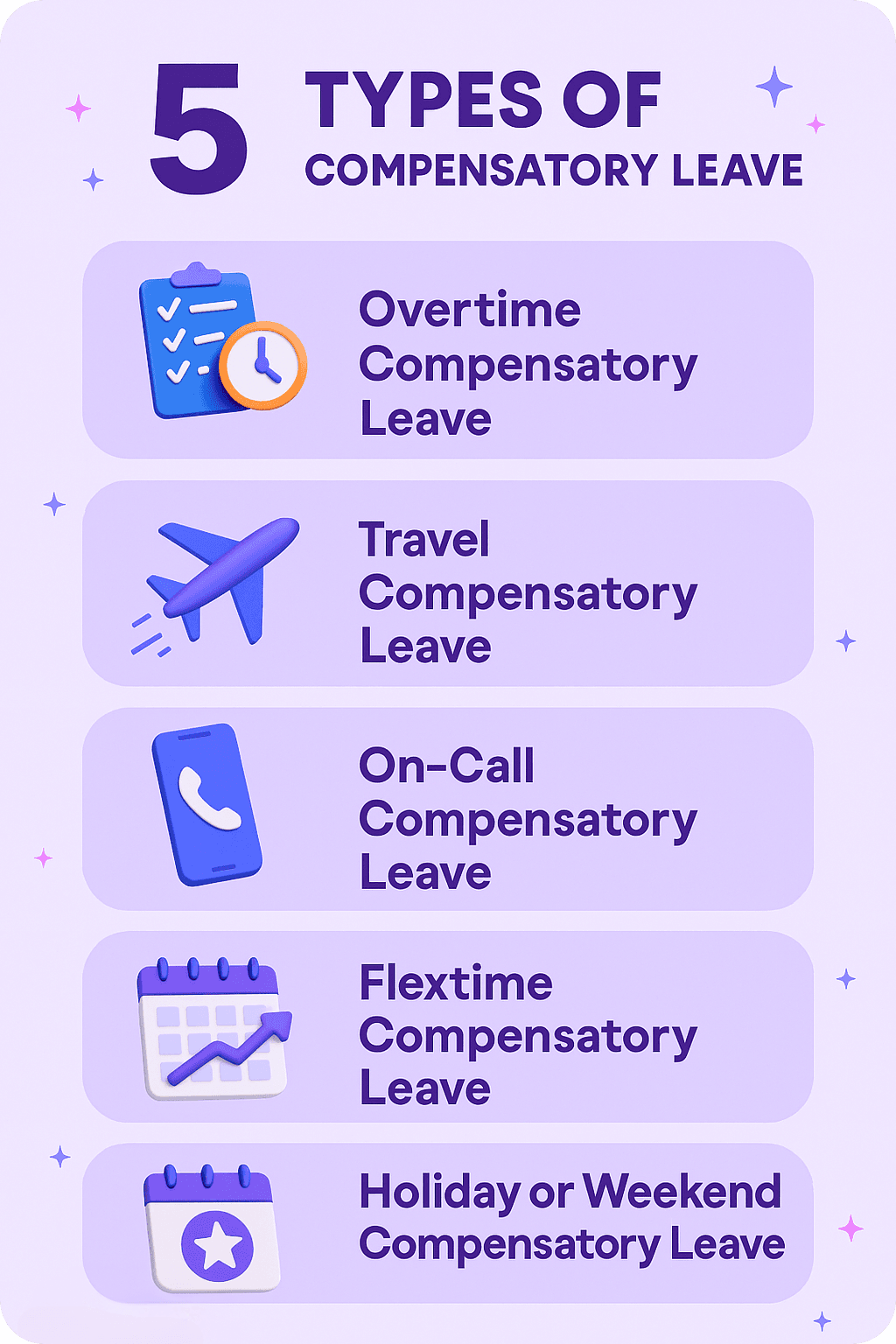Last updated on November 14, 2025
While no manager wants to overwork their team, sometimes it’s unavoidable.
Whether you’re close to a major deadline, powering through your busiest seasons (like accountants in April or retail stores in December), or dealing with a staffing shortage due to illness, sometimes you have no choice but to ask your team to stay at work a little longer.
But how can you fairly ask your team to work more if they’re not eligible for overtime pay? That’s where compensatory leave comes in.
Want to know more?
In this article, we’ll walk you through everything you need to know about compensatory leave, from who’s eligible and the different types available to how it’s calculated and implemented. Let’s dive in!
What is Compensatory Leave?
Compensatory leave, also called time off in lieu (TOIL) or comp time, is when you reward extra hours worked outside of their regular hours with extra time off in their PTO bank. If your organization offers additional PTO instead of overtime pay, you’ll want to create a clear time off in lieu policy to outline how it’s earned, tracked, and used.
Comp leave can be an effective cost-control measure for businesses, especially if their budget is tight and they can’t afford to pay their employees overtime above their salaries. However, it’s crucial to verify whether compensatory leave is legal in your country or region.
The Difference Between Compensatory Leave and Overtime
Businesses must choose between two primary methods of rewarding hours worked beyond the standard workweek: overtime pay or comp time. So, what’s the difference?
1. Overtime Pay
- Typically paid at 1.5 times the regular hourly rate, or higher, depending on laws in your area.
- Provides immediate financial compensation to employees.
- Can increase labor costs for businesses if overtime is frequent.
2. Compensatory Time Off
- Grants employees additional time off in lieu (TOIL) of paying overtime wages.
- Helps manage expenses by reducing overtime payroll costs.
- Must be carefully tracked and managed to avoid confusion or legal risks.
5 Types of Compensatory Leave
Compensatory leave can come in various forms, depending on how and when employees accrue hours. Understanding these categories can help managers and HR design or refine their company’s leave policy.

- Overtime Compensatory Leave: Extra hours worked beyond the standard workweek are rewarded as additional time off instead of overtime wages.
- Travel Compensatory Leave: If someone travels for work outside of normal hours, they might earn extra time off. Some companies count all travel time, while others only count time beyond regular commuting.
- On-Call Compensatory Leave: Employees who are on standby outside their usual hours may get comp time, even if they don’t end up working. Rules around this can vary, so it’s important to check local labor laws.
- Flextime Compensatory Leave: Sometimes, employees work longer days so they can leave early another day. If those extra hours go beyond what’s normally allowed (usually 8 hours), it might count as comp time.
- Holiday or Weekend Compensatory Leave: Working on a holiday or weekend might earn someone extra time off. In some places, the law requires this or even extra pay, so make sure your policy follows local rules.
Who Is Eligible?
Eligibility for compensatory leave varies by region and employment type. In general, public sector organizations and government agencies are more likely to offer comp time, as many jurisdictions allow it for exempt employees under specific conditions.
On the other hand, private companies must follow strict labor laws which typically make overtime pay the safer and more compliant option, especially for non-exempt employees. Offering comp time in the private sector without fully understanding the legal framework can lead to compliance risks and potential penalties.
For example, in the United States, eligibility is guided by the Fair Labor Standards Act (FLSA):
- Hourly employees (non-exempt) are entitled to overtime benefits. In some cases, employers can offer comp time instead of overtime pay.
- Salaried employees (exempt) are typically not eligible for compensatory leave if they earn above a certain salary threshold, currently $35,568 annually.
In Canada, comp time is allowed under certain conditions. Employees must agree in writing to receive time off instead of overtime pay, and the time off must be taken within a limited period, typically within 3 to 12 months of earning it.
Here are a few provincial examples:
- Ontario: According to the Employment Standards Act, public sector, non-unionized employees who work over 44 hours per week can bank 1.5 hours of paid time off for every hour of overtime worked. Employees must use the time off within three months, unless a written agreement extends it up to 12 months Salaried employees are also eligible for overtime pay unless exempt.
- Alberta: This province’s Employer Standards Code allows employees who work more than 8 hours per day or 44 hours per week to receive 1 hour of time off per hour of overtime worked. Comp time must be used within six months unless otherwise agreed in writing. Salaried and hourly employees are both entitled to overtime benefits, although certain employees are not eligible.
Because employment standards vary by province/state and country, it’s essential to consult local legislation or an employment lawyer to ensure your comp time policies remain compliant.
If you need a hand understanding compensatory leave eligibility, our leave laws resource is equipped with rich information about how to stay compliant in your region.
How to Calculate Compensatory Leave
Compensatory leave rates often mirror overtime rates, meaning if employees normally earn 1.5 times their hourly pay for every hour of overtime, they would earn 1.5 hours of comp leave for every extra hour worked. While uncommon, some regions, like Alberta, require a minimum 1:1 ratio of overtime hours to comp time off, so make sure to review your local labor laws.
Compensatory Leave Formula
X Hours of Overtime Worked x 1.5 = Hours of Compensatory Time Off
Let’s try an example:
If an employee works 42 hours in one week, when they usually work 37.5, that means they worked 5 hours of overtime.
To calculate compensatory leave, we’ll multiply 5 hours of overtime by 1.5 to get 7.5 hours of comp time.
If that same employee were to be paid overtime, they would receive 1.5x their hourly salary. If they earned $40 per hour, we’d multiply their hourly rate by 1.5 to get their hourly overtime rate, which would be $60. Then we’d multiply $60 (their overtime rate) by 5 (number of overtime hours worked) to get $300.
That means that the employee would either be eligible for $300 of overtime pay or 7.5 hours of compensatory time depending on their company's policy.
Creating a Compensatory Leave Policy
Documenting your compensatory leave policy helps ensure consistency, legal compliance, and transparency across your organization. As you build your policy, here are a few key areas to consider:
Accrual Caps: Set a maximum limit on how much comp leave an employee can accrue at once. If they reach this accrual cap, they cannot continue to accrue leave until they use it or receive a payout.
Payout Options: If an employee leaves the company with unused compensatory leave, decide whether they’re entitled to payment at their current hourly rate.
Expiration Dates: Some companies implement a “use it or lose it” model, requiring employees to use accrued comp leave within a set period, like 6 months.
Advance Notice: Clarify how far in advance employees must request compensatory time off to avoid disruptions or scheduling conflicts.
Feeling stuck drafting your policy? Use our Leave Policy Generator to create a custom policy in just a few clicks. It’s a great way to get started and ensure your team stays aligned and informed.
How to Implement Comp Leave
If you’d like to start offering comp time in place of overtime pay, the first step is learning the rules that apply to your remote and on-site workforce. Consulting legal experts is the best course of action. FLSA violations can cost thousands in penalties, or your company can get sued by a damaged employee if their rights are violated.
Next, gather your managers and HR department to discuss the way you’ll introduce this new option to your employees. The department and company leaders need to be familiar with comp time rules, so they can approve or decline the compensatory time off employees have earned and requested.
Now, all it’s left is to inform and educate the staff about compensatory time off. Create a knowledge base so they can remember how to create the compensatory time off request, what rules apply to them, how to track time off, and how many days or hours they have left.
Keeping Track of Comp Leave
Offering compensatory time rather than overtime pay can be a cost-saving solution for growing businesses that need manpower but can’t afford to pay overtime. However, it does come with the added complication of needing to track a new form of leave.
If you’re already drowning as is in spreadsheets or paper forms just managing basic leave like sick days or vacation, you’ll need a system in place to track everything from requests to approval, and usage. Plus you’ll want to make sure there are no gaps in coverage when your employees are using up these extra days off.
So how do you make sure you don’t lose track of who earned what, and when?
We recommend using a leave management system to track accrued TOIL hours and approvals in real time. This means no more manual calculations, no more updating spreadsheets, and no mistakes. Instead, your compensatory leave manages itself, ensuring total policy compliance and no costly legal issues.
Vacation Tracker is loved for its ease of use and extensive and constantly growing set of features, including TOIL (of course!). Employees can request compensatory leave directly in our system or from Slack or Microsoft Teams. That request is then routed to their designated approvers. Once approved, the time is added to their leave quota. Employees can easily access their own PTO balances, fostering trust and improving transparency. Managers can export detailed reports that identify employees' usage and balances of TOIL and compare it to other types of leave accruals, for total clarity on their team's time off habits.
Want to see it in action? Check out our video demoing this feature.
Recap
From a management perspective, compensatory leave can be a smart way to recognize extra effort, manage labor costs, and offer employees more flexibility. But to make it work, you need a well-defined policy that outlines eligibility, accrual rules, tracking methods, and usage timelines.
Need a simpler way to manage it all? Vacation Tracker takes the guesswork out of tracking comp time. Accurate and up-to-date leave quotas and automated approval workflows make it easy to stay compliant, without spreadsheets or manual follow-ups.
Start for free today and see how Vacation Tracker helps you manage compensatory leave with clarity and confidence. You can also try all features with a 7-day free trial.

Claudia
Claudia is an experienced marketer with a passion for writing and creating engaging content that connects with readers.




